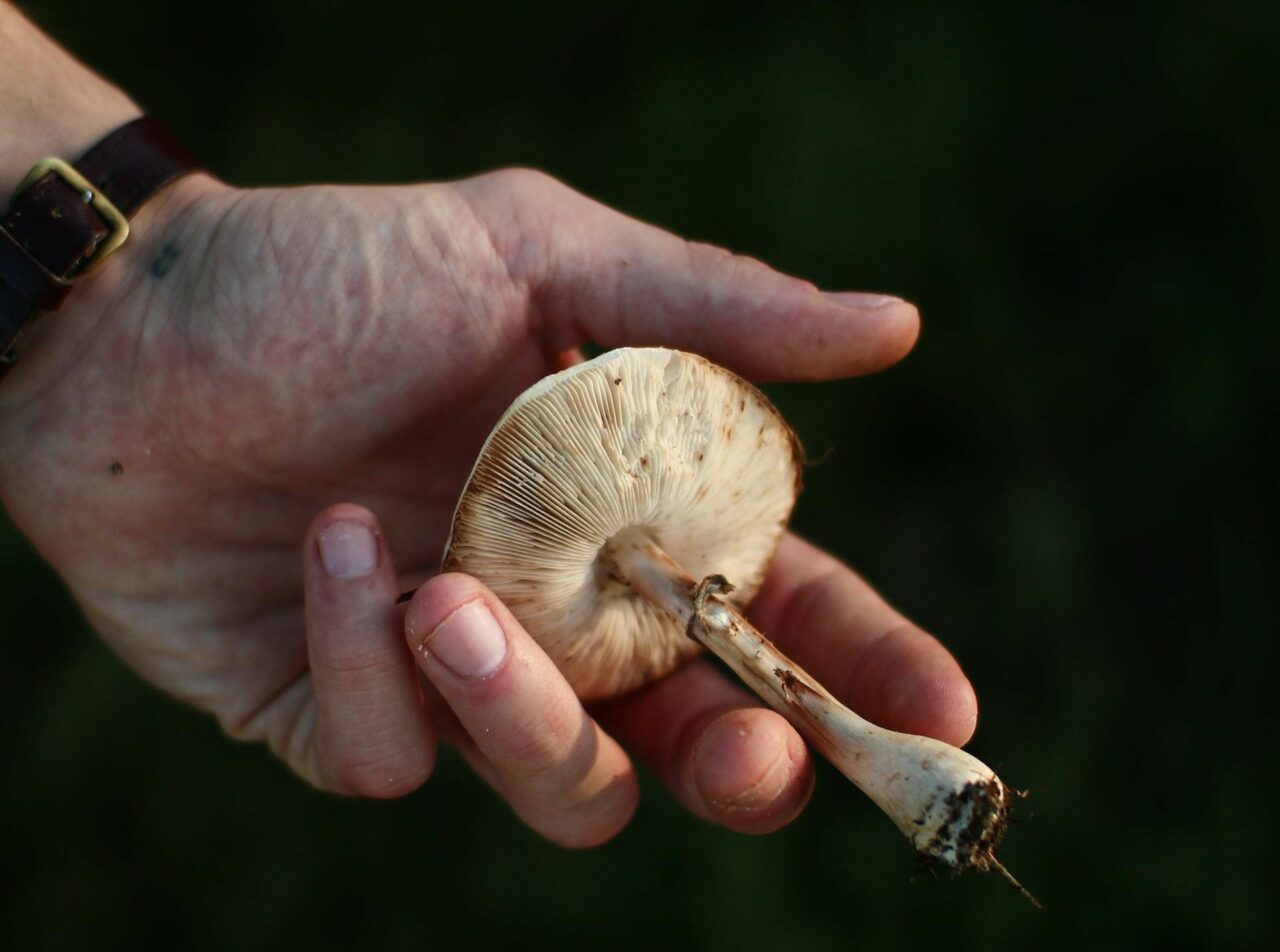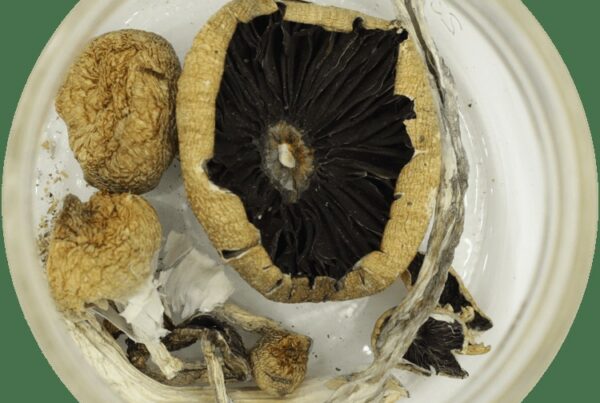Traditional psychedelics, such as Psilocybin mushrooms that function like LSD by acting as a serotonin 5-HT2A receptor agonist, are currently under investigation for their potential role in psilocybin-assisted therapy. This therapy is being explored for mental health disorders including major depression, anxiety, emotional distress, cluster headaches, and migraines.
In order to understand how shrooms help in treating these conditions, it’s essential to delve into their metabolic process in the body. This knowledge empowers both researchers and users to grasp how the active compound produces psychological and therapeutic benefits. This article offers a basic overview of psilocybin’s pharmacology and pharmacokinetics.
[toc]
Key Takeaways:
- Upon oral consumption, half of the psychedelic fungi is absorbed and distributed throughout the body.
- The enzyme alkaline phosphatase primarily in the liver dephosphorylates the fungi compound.
- Within 24 hours, about 3.4% of the compound is expelled in its original form, with the majority being eliminated as a stable metabolite.
What is Pharmacokinetics?
Pharmacokinetics (PK) involves the study of how substances like drugs are processed by the body once they are introduced into the system. It’s a distinct, yet related field to pharmacodynamics, which studies how a compound interacts with the body. PK primarily focuses on four areas: absorption, distribution, metabolism, and excretion (ADME).
Understanding these processes is key for healthcare providers when prescribing the most effective medications with the least amount of risk. It also allows them to customize treatments based on each patient’s unique physiological and lifestyle factors.
How Does Pharmacokinetics Relate to Psilocybin?
The dominant active compounds in some magic mushroom species, psilocybin and psilocin, have garnered significant attention from both researchers and users. Pharmacokinetics explores how psilocybin-containing mushrooms are processed by the body, enabling us to comprehend their potential effects, whether for medicinal or recreational purposes.
These compounds, known by various names such as “magic,” “psychedelic,” “medicinal,” or “sacred,” are present in mushrooms that are ingested. The mushroom species, their place of origin, size, growth and drying conditions, and age can significantly affect their compound concentrations.
These mushrooms naturally grow in the wild, but scientists have also developed techniques to create them in a lab. Both the naturally occurring and lab-created versions exhibit low toxicity, albeit mild side effects like nausea or vomiting may occur.
Despite the potential physical effects, the compounds found in these mushrooms have demonstrated therapeutic potential due to their safe profile and non-addictive properties. This has prompted researchers to explore their use in psychotherapy, particularly as a treatment for conditions such as anxiety and depression.
The Four Stages of Pharmacokinetics
Psilocybin, the active compound in these mushrooms, is inactive in its initial form and functions as a prodrug, converting into its active variant, psilocin. This conversion is facilitated by enzymes, like alkaline phosphatase, which enables psilocin to be absorbed and circulated throughout the body to reach different tissues. However, following oral administration, psilocybin is undetectable in the circulatory system, feces, or urine.
Absorption
The process of absorption refers to the mechanism by which the compound goes from its administration site into the bloodstream. This largely determines the rate and effectiveness with which the compound reaches its target, such as the plasma. Oral administration is the most commonly used method. Although inhalation has been attempted, it is not as effective as consuming orally.
The absorption process also encompasses the release of the compound from the dosage form during oral ingestion. Various factors, like delays in the throat or esophagus, can impact this, potentially leading to slower results or irritation. Once the compound arrives in the stomach, the acidic environment may start to break it down before it enters the bloodstream.
According to animal studies, approximately 50% of orally administered psychedelics are absorbed and dispersed throughout the body.
Factors Influencing Absorption
Several factors can impact the absorption process, leading to differences in the onset, intensity, and duration:
- Stomach Contents: A full stomach can delay absorption as it slows down the onset of effects. Conversely, an empty stomach can allow for faster absorption.
- Body Fat: Substances may accumulate in fat tissues, potentially prolonging their effects.
- Age: Metabolic rates and body composition can change with age.
- Zero-Order Kinetics: The substance is removed at a constant rate, regardless of its concentration.
- First-Order Kinetics: The elimination rate is directly proportional to the concentration of the drug.
The term ‘dispersion’ is used to describe how psilocin spreads throughout the body once it enters the bloodstream. As psilocin is lipophilic, it can cross the blood-brain barrier and enter the central nervous system.
This process is influenced by factors such as the size, polarity, and protein-binding capability of the substance, as well as a person’s physical characteristics, including hydration status and body composition.
The goal is to achieve an effective concentration at the target location. For the substance to work effectively, it must reach the intended area, as specified by the distribution volume, and remain unbound to proteins. This allows it to actively interact with its receptor.
What Factors Can Affect Dispersion?
Several factors can influence this dispersion process:
Usually, the effects start to be noticeable within 20-40 minutes of consumption, peaking around 80-100 minutes. The effects of magic mushrooms typically last between 4-6 hours.
How is Dispersion to the Brain Achieved?
An early experimental study on two species found that the sequence of its binding affinity is 5HT2A > 5HT1A > 5HT2B [23]. It also binds to dopamine D1, 5HT1E, 5HT5A, 5HT7, 5HT6, D3, 5HT2C, and 5HT1B receptors.
At the 5HT2A receptor, it acts as a partial agonist, with an efficacy of about 40%. The psychedelic effects are linked to its partial agonist activity at 5HT1A autoreceptors.
The mood-enhancing and psychotomimetic experiences may stem from the observed correlation between increased dopamine levels and feelings of depersonalization and bliss. Hallucinogens work by modifying neurochemistry and receptor activity. They enhance 5HT2A agonist activity by increasing BDNF synthesis in the hippocampus, which promotes neurogenesis and reduces conditioned fear-related behaviours.
Elimination
Elimination refers to the process by which the The human body expels compounds primarily through organs such as the kidneys, lungs, skin, and gastrointestinal tract. When dealing with the kidneys and a naturally occurring psychedelic drug, it’s either filtered in the glomerulus or secreted in the tubules. The process is further complicated by some reabsorption.
The primary compound has a half-life of around 160 minutes. In contrast, psilocin’s half-life is approximately 50 minutes. Studies on animals have indicated that the majority of this is excreted in the urine, comprising about 65% within 8 hours. Even after consumption, small amounts of the substance can be detected in the bile and feces.
In human beings, around 3.4% of the substance is expelled unaltered within a day. The bulk is eliminated as psilocin-O-glucuronide, a more stable metabolite. The stability of this compound allows it to be identified in urine tests for a prolonged period.
Substance expulsion primarily occurs in two ways:
Most psychedelic substances follow the first-order kinetics method, reaching stable concentrations after four to five half-lives. Complete elimination also generally occurs after four to five half-lives.
Discover Our Range of Hallucinogenic Mushrooms
The metabolic process differs across various types of fungi. By choosing trusted online providers like Magic Mushroom Delivery Canada, you can prevent unintended consumption of poisonous mushrooms. Certain varieties, like Agaric mushrooms, may generate intense and undesirable effects. Hence, it’s essential to procure magic mushrooms from reliable suppliers as opposed to potentially dangerous street vendors or wild foraging.
| Feature | Enigma | Full Moon Party | Gold Member | |
| Strain Type | Psilocybe Cubensis OMNI | Psilocybe cubensis (Thai Koh Samui) | Psilocybe cubensis | |
| Potency | Exceptionally strong; 3.8% tryptamine content | Medium to high strength | High strength | |
| Visual Characteristics | Appears like a blob or | Resembling cauliflower or a brain in structure | Typical appearance of cubensis; of average size | Broad white stems; caps of golden caramel; evident blue bruising |
| Effects | Known as the most potent; triggers strong effects | Intense mental high; onset is delayed with visible hallucinations | Powerful hallucinations and feelings of joy |
Study Psilocybin Mushroom Use Online
It’s crucial for medical professionals, researchers, and users to comprehend the pharmacokinetics of shrooms. This understanding allows you to make educated decisions about dosage and timing, thus reducing potential hazards.
Discover your perfect psychedelic experience at Magic Mushroom Delivery Canada. Whether you desire a soothing trip or a deeper exploration, our extensive product selection is designed to meet your specific requirements. Enjoy high-quality, safe, and regulated shrooms, eliminating worries about uncertain sources or poisonous mushrooms.
Experience the best magic mushrooms Canada has to offer and enhance your psychedelic journey to unparalleled heights.
Frequently Asked Questions
Are there known interactions between shrooms and other medications?
Our products may interact with certain medications, particularly those affecting serotonin levels such as SSRIs (Selective Serotonin Reuptake Inhibitors). SSRIs and SNRIs (Serotonin and Norepinephrine Reuptake Inhibitors) often lessen the effects, unlike non-serotonergic antidepressants. This reduced effect can last for up to three months after stopping the use of antidepressants.
Do all psychedelics work the same way as psilocybin?
No, each psychedelic substance has a unique structure which requires different metabolic processes to activate, and they attach to various receptors in the body. The way the psychedelic is administered also affects how each one is absorbed. While the basic principles of absorption, metabolism, and distribution remain the same, the specific pathways and effects vary for each substance.
Can the form of the shroom affect the pharmacokinetics?
Yes, the form (whether fresh, powdered, or dried mushrooms) can influence the speed of absorption. For example, powdered forms may be absorbed faster than whole dried ones due to quicker dissolution.
Additional Reading:





